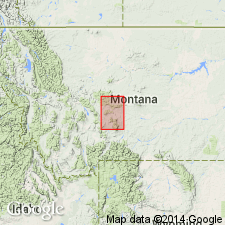
- Usage in publication:
-
- Smith River lake beds
- Modifications:
-
- Original reference
- Dominant lithology:
-
- Sand
- Conglomerate
- AAPG geologic province:
-
- Montana folded belt
Summary:
Smith River lake beds. Irregulary bedded sands and loosely cemented conglomerates, with beds of marl and volcanic dust. Deposited in lake that once filled valley of Smith River, between Little Belt and Big Belt Ranges, Little Belt Mountains region, central southern Montana. Rest unconformably on all older rocks. Contains middle Miocene fossils.
Source: US geologic names lexicon (USGS Bull. 896, p. 2014).

- Usage in publication:
-
- Smith River lake beds†
- Modifications:
-
- Abandoned
- AAPG geologic province:
-
- Montana folded belt
Summary:
†Smith River lake beds. The stream for which these beds were named Smith River is now known as Deep River. (See Deep River beds.) The beds have also been called "Smith Creek beds."
Source: US geologic names lexicon (USGS Bull. 896, p. 2014).
For more information, please contact Nancy Stamm, Geologic Names Committee Secretary.
Asterisk (*) indicates published by U.S. Geological Survey authors.
"No current usage" (†) implies that a name has been abandoned or has fallen into disuse. Former usage and, if known, replacement name given in parentheses ( ).
Slash (/) indicates name conflicts with nomenclatural guidelines (CSN, 1933; ACSN, 1961, 1970; NACSN, 1983, 2005, 2021). May be explained within brackets ([ ]).

